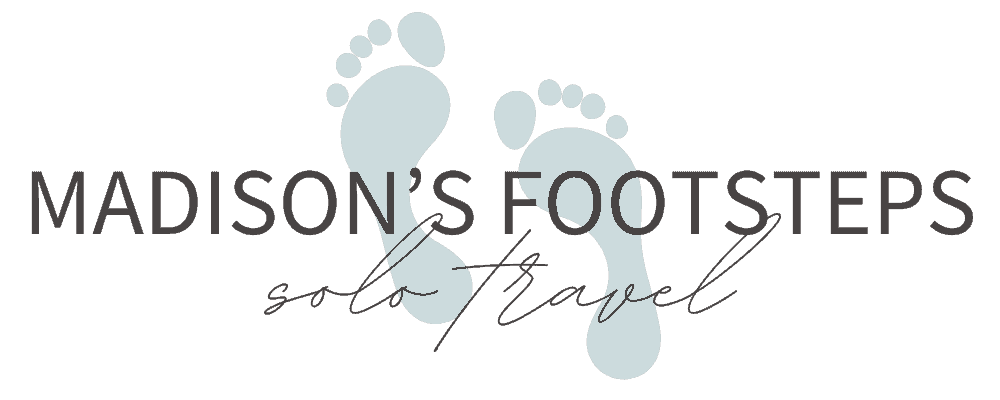What to Pack When Studying Abroad in Europe (for Women)
**This post contains affiliate links, which means if you buy something through those links I will receive a small commission at no extra cost to you. Click here to view my legal page. Thank you for your support!
Not sure what to pack when studying abroad in Europe? Consult my handy semester abroad packing checklist – from a former study abroad student (in Rome).
In 2017, I completed the visa paperwork and took the first step towards the best five months of my life – my study abroad semester at John Cabot University in Rome. But before I could board my flight and get the party started, I had to answer the difficult question: what to pack when studying abroad in Europe?
In my opinion, the hardest part about moving abroad for a semester was figuring out what to put in my suitcase. I spent weeks stressing over every last item, worried that the American products I was used to wouldn’t be available in Italy. Luckily, I had a few friends who had already lived abroad to fill me in on essential items for Europe study abroad.
If you’re a college student preparing for your semester abroad, I’m here to make your transition a little easier. Whether it be clothes, shoes, or helpful tech – here’s what to pack when studying abroad in Europe!


The Lazy Girl’s Guide to Study Abroad Essentials
If you’re short on time or too busy planning out your travel itinerary, simply screenshot the packing list below for studying abroad in Europe. It gives you all the essentials in an easily digestible, no-frills checklist!
Psst…or click below to download the full packing list with all of the traveling clothes for Europe, toiletries, travel essentials, and unique finds that need to be in your suitcase before your semester abroad.
👉🏼 Click here to download my free Europe Study Abroad Packing List PDF!

What to Pack When Studying Abroad in Europe
If you’re wondering what to pack for Europe for your semester abroad, rest assured you’re in the right place. Beyond the obvious essentials (shirts, socks, makeup, etc.), there are plenty of unique items you need for study abroad that you wouldn’t know…unless you’ve already been.
That’s where I come in! I studied abroad in Italy back in 2017 and returned in 2018 to live and work in Florence for another 18 months. Long story short – I’m an expert on what you need for budget-friendly European travel. Keep reading for study abroad must haves or simply download my printable semester abroad packing list and skip the reading.
Voltage Converter
When it comes to things to pack for Europe, make sure you come prepared with 1-2 voltage converters suited for your host country. Many come with a few different plug options in one – so you can use the same converter on a trip to Rome that you would on a trip to the U.K.
Unfortunately, not all converters are created equal. I had a bad experience with the first converter I purchased after it murdered my phone battery. This voltage converter from Amazon is consistently rated the best for European travel. I used it on my last trip to Lisbon and had a great experience. I would definitely suggest investing in a converter you can trust. You’ll thank me later when your iPhone doesn’t break!
Plug Adapter
Did you know that there’s a difference between a voltage converter and an adapter? If the answer is no don’t feel bad, I found this out embarrassingly recently.
A voltage converter’s job is to change the voltage found in an outlet to match your electronic devices. For example: American appliances run on 110 volts, while European appliances run on 220 volts. If you plugged your – let’s say – camera charger into a voltage adapter in Europe, it would convert the voltage to 110 volts so it wouldn’t fry your device.
A plug adapter, on the other hand, simply changes the shape of a plug to fit an outlet. I definitely recommend traveling with both since many electronics, like Apple products and certain hair tools, are dual-voltage and don’t require a voltage converter to work.
Combination Lock
If you plan to stay in any hostels during your time abroad, make sure to bring your own combination lock. Most hostels will have some sort of locker system in their dorm rooms, but very rarely do they supply the locks for free. Sometimes you can rent them out for a fee at the front desk, but this seemingly small fee will add up when you’re staying in different hostels every weekend.
In my experience, usually the lockers aren’t big enough to fit all your luggage, but it’s always smart to lock up your passport, extra cash, credit cards, and any electronics you’re carrying with you – especially chargers which are very easy to steal.
👇🏼 A quick Horror Story to Convince You to Lock up Your Possessions…
I visited Madrid in the spring of 2017 with a friend from college and we stayed two nights at the Hostel Meeting Point. We booked two beds in an 8-bed all-female dorm and ended up overlapping with 30 students on a middle school field trip (which was a shock, to be sure).
When we came back from sightseeing later that day, we walked into our room and my friend’s bed was completely empty. Her suitcase, purse, and toiletry bag that had been sitting on the counter had all completely disappeared, including her passport which was hidden in the bottom of her bag. We had an early flight to Barcelona the next morning, but she wouldn’t be able to board without her passport.
We alerted the front desk immediately and, after a bit of scrambling and panicking, we found her luggage in another room where one of the middle school chaperones had mistakenly moved it. Although this particular situation was clearly an accident, neither of us would have been nearly as panicked if her passport and credit cards had been locked up with mine.
**I would like to make it clear that this was not the hostel’s fault in any way. We had a great experience at the Hostel Meeting Point, it was close to all the sites and the staff was very accommodating. We would definitely stay there again!

Microfiber Towel
My friend suggested that I invest in a packable microfiber towel before I leave, and I was very glad she did. I brought my microfiber towel on every trip we went on, and saved myself a lot of money in the process. Most hostels will offer towel rentals at the front desk, but it’s almost always for a fee and they sometimes ask for a deposit as well. Usually, it’s around €2-5 for the rental but I’ve heard of hostels charging as high as €18.
Amazon sells these microfiber towels for only $22. They fold up neatly in their little pouch, so they don’t take up much space in your suitcase. I bought a pink set in 2017…and I’m still using it as a digital nomad in 2024 – they last that long!
P.S. Since I’m a haircare girlie, I always bring a microfiber hair towel as well to minimize the damage that traveling has on your luscious locks. When you’re clubbing in the Czech Republic one weekend and scuba diving in Madeira the next, your haircare routine is bound to suffer the consequences.
Portable Charger
There’s nothing more annoying than only having two days in a new European destination and worrying about charging your phone the whole time. A month into my semester, my shitty voltage adapter fried my iPhone’s battery and the charge wouldn’t last more than a few hours at most. I spent too many trips worried about how I would get back to the hostel without Google Maps (a must-have app for Europe) when my phone died.
…Cue me stuck at the Apple store in London for two hours while my friends went to see the London Eye.
When I moved to New York in 2017, I finally invested in a good portable charger. You can spend anywhere from $5-50, but in my experience, you don’t need to spend more than $30. Amazon sells my favorite Anker Portable Charger for only $27.99. Just plug it in overnight and it’ll charge your phone fully 3-4 times. I’ve used this portable charger in my travels all over the world – from when I lived in Honduras to the four months I spent in Canggu, Bali.
Dual-Voltage Hair Tools
If you’re a bit of a high-maintenance traveler like myself and can’t travel without your trusty hair dryer, curling iron, and straightener, then make sure to invest in few dual-voltage appliances before you leave. Many voltage adapters are not compatible with hair tools, and, if you’d rather not have a half-melted straightener on your hands or be the one responsible for a power outage, it’s smarter to invest in dual-voltage alternatives. This Conair Travel Hair Dryer is compact, dual-voltage and inexpensive at only $21.99 on Amazon. You can also use it in the U.S. when you come home, just flick the voltage switch.
Compact Carry-On Bag
Before I left for the semester, I invested in a new carry-on bag that was half-rolling suitcase and half-backpack. The best part about my new carry-on was that I could roll it around town or in the airport when it was too heavy (all the time), but I could throw it on my back before I got on the plane. I learned quickly that nobody questions the weight/size of a carry-on if it’s on your back. This feature saved me a lot of money in luggage fees because, let’s be honest, my bag was ALWAYS overweight. Although the exact bag I used is currently unavailable, you can find this similar model on Amazon.
If you’re more of a hard-sided luggage type of traveler, I suggest you check out Calpak Travel! They sell adorable, hard-sided carry-on bags that are the perfect size for your semester abroad. I especially love their Hue Carry-On and, let’s be honest, absolutely anything in their Terra Collection (I already own the Terra backpack, sling bag, and bathroom bag in glacier blue).
Osprey is another great brand when it comes to shopping for the perfect carry-on bag. I’m a little lazy, so I prefer a roller bag over a backpack. This roller model is definitely on my travel wishlist! It’s great quality and the perfect size for a weekend trip in Europe.
Plastic Travel-Size Bottles
If you don’t plan on checking a bag every time you travel to another country, it’s smart to stock up on a bunch of these reusable, travel-size bottles. Amazon sells leak-proof 4-packs of them for $6.99. I always like to bring extras since getting one liquid out to replace with another liquid is pretty much impossible without a dishwasher.
Rubber Flip Flops
Think of hostel showers like dorm showers – never EVER get in one without wearing flip-flops. You never know what’s growing in there… and you definitely don’t want to find out. Flip-flops also come in handy when you’re traveling to beachy destinations like Split, Croatia, or a glorious weekend in the French Riviera.
If you want to go with something simple, there’s always the classic flip-flop from Old Navy. They’re also offering a new style that’s a little more interesting than their classic pair. If you want to invest in a nicer pair that will last longer (the more eco-friendly choice), then check out the flip-flop options from Reef.

Jeans
Coming from a girl who lives her life in Lululemon leggings, trust me when I say jeans are a must-have on the list of Europe travel clothes. Athleisure wear doesn’t exist over there, and black jeans seem to be the go-to fashion trend in most countries. I brought four pairs of leggings and only ended up wearing them once or twice.
If you’re really against denim, American Eagle sells some great pairs of black jeggings that are almost as comfy as your trusty old Lulus. I wore mine for three months straight until an Italian dryer destroyed them and I had to throw them away in a trash can in Madrid. RIP, literally.
Europe has also finally begun to accept the Mom Jean trend! I’m obsessed with this ripped pair and this classic option from American Eagle.


Passport Holder
Although it may seem unnecessary, my passport holder really came in handy when organizing all my travel documents. If you’re a study abroad student, you’ll most likely have a permit-to-stay or visa documents that you’ll need to keep on you when traveling to other countries in Europe. Investing in a nice passport holder or travel organizer will help keep all of these documents straight.
I prefer passport holders made of leather since they tend to be more durable in the long run. This classic Coach case in black leather is one of my favorites or, if you’re looking for a more affordable option, try this brown leather case from Fossil. For more color choices, check out these personalized leather passport holders on Etsy.
First Aid Kit & Prescription Medication
This is a pretty obvious one, but make sure to stock up on all your medications before moving abroad. It can be very difficult to find good substitutes in foreign countries. This is especially important with prescription medication. It can be next to impossible to get a prescription from home filled in Europe, without flat-out booking an appointment with a European doctor. I stocked up on plenty of Dayquil, Nyquil, and Ibuprofen for my semester and I was very happy I did! We were sick every weekend from traveling so often.
If you’re prone to infections or just plan on visiting remote locations with limited access to medical care, I highly suggest adding the Jase Case to your list of what to pack when studying abroad in Europe. This is one of the things I wish I brought to study abroad, it would have made my life a lot easier. It comes stocked with medications like Azithromycin, Ciprofloxacin, Doxycycline, and Metronidazole (all prescribed by doctors), plus a handy emergency antibiotic guide.
Copies of Important Documents
I cannot stress this one enough – make sure to add copies of your important documents to your study abroad packing list. I would suggest making both hard and electronic copies on Google Drive or iCloud. This includes your passport, driver’s license, student ID, student visa, permit-to-stay, insurance cards, and any other documents you’re carrying that are crucial to you living abroad legally and safely. I emailed a copy of everything to my parents and uploaded them to my Google Drive so I could access them from any computer. I also printed out a copy of my passport to keep on my person so I could keep the real thing safely locked up in the hostel.

A Debit Card and Extra Credit Card
I didn’t think this needed to be said until I met someone who planned a three-month Europe trip with NO DEBIT CARD.
Let me be as clear as possible – if you’re wondering what to pack for study abroad in Europe, a debit card needs to be on the list. It’s the only reliable way to get cash out in a foreign country.
Additionally, I always travel with four credit cards in case of an emergency. Four might be overkill, but don’t leave for your semester abroad without at least two credit cards with decent limits (and separate them whenever you’re traveling).
Neck Pillow
When I got back to the U.S., I tallied up the flights I had taken during the semester. The answer was 32, and a lot of my friends had even more than I did! That’s a lot of hours of uncomfortable plane naps. Do yourself (and your neck) a favor and add one of these inflatable travel pillows to your list of what to pack when studying abroad in Europe.
Eye Mask
A comfortable eye mask is a must when you’re taking trips every weekend. It comes in handy on an airplane even if you sleep like the dead…especially if Ryanair decides to turn the lights on in the middle of the night so they can sell you perfume.
If you’re looking for a mask with some sass, look no further than these comfy, funny eye masks from Etsy: the “Go Away” mask and, my personal favorite, “Wake Me Up for Brunch”. If you want to get serious about it, you can try this Nidra Sleep Mask from Amazon – it’s apparently completely light-blocking.
Reusable Water Bottle
The nice thing about Europe is, for the most part, the tap water is completely safe to drink. No need for a fancy, self-filtering water bottle. In Interlaken, you can even drink the water directly out of the lake.
Since the water is so safe, there’s no need to purchase plastic bottles everywhere you go. Instead, invest in a long-lasting reusable water bottle, like a Hydroflask. Personally, I prefer to bring both a Hydroflask and a YETI tumbler with me when I travel. That way, I can keep my Hydroflask for water and use my YETI for beer, coffee, etc.
Apple Airtag
I recently was gifted an Apple AirTag for Christmas and my life changed forever. Of course, the first flight I took after receiving it the airline lost my luggage (which was extremely hard to recover since Roatan has no addresses). It was such a comfort to be able to track my bags as they made their way back to me. You can also put an AirTag in your wallet or attach it to your keys!
At only $29, a steal for Apple, there’s no excuse not to grab one or two for your next trip. However, do yourself a favor and skip the overpriced Apple keychains. Grab one of these affordable options from Amazon instead.
What Not to Pack for Study Abroad (Buy it There Instead!)
In addition to knowing what to pack when studying abroad in Europe, it’s also important to know what not to pack. Leave the items below at home – they’ll still be there when you get back.
- Shampoo & conditioner
- Food – trust me, it’s better where you’re going
- Thin heels – the cobblestones will destroy them
- Easy-to-find toiletries like nail polish remover, shaving cream, and mouthwash
- Non dual-voltage hair tools – leave your Dyson Airwrap at home
- Mace/pepper spray – there’s a good chance it’s illegal in your host country
- Books – you won’t have room. Instead, grab a library card before you leave home and sign up for free book rentals on the Libby App
- Expensive jewelry
- Tons of local currency – just visit an ATM when you arrive
- Clothing that requires dry cleaning or that won’t fit properly if it’s air-dried

Helpful Packing Tips
- Roll your clothes to optimize space in your suitcase
- Put heavy items in your carry-on (shoes, hair tools, etc.) to maximize space in your checked bag
- Try packing cubes (although I personally prefer to go without them)
- Leave some space…or bring some things you plan on leaving behind (gotta make room for souvenirs!)
- Plan out whole outfits instead of throwing clothing items willy nilly into your suitcase
- Wear your heaviest items on the plane
- Step up your fashion game – because you know the Europeans are always dressed to the nines
- Consider the local culture when you’re choosing clothes (Ex: I would not bring crop tops for a study abroad semester in Morocco)
FAQs About What to Pack When Studying Abroad in Europe:
I recommended to start packing for your study abroad trip at least one month before departure. This will give you enough time to gather all the necessary items and avoid any last-minute stress.
I actually started packing around two months before, to leave extra extra time in case I needed to order anything that would take a while to ship.
Pack heavier items in your carry-on, like shoes, as well as expensive jewelry and electronics, and prescription medication. Carry-ons are generally not weighed by airlines, so pack that shit as full as you can!
This might be a controversial option, but I don’t think you need to bring any local currency for study abroad (unless you like using USD in your home airport).
Pretty much every airport in Europe is going to have an ATM in the arrivals terminal. Get out your trusty debit card and grab some cash before you get in a cab. You’re pretty much guaranteed to get a better conversion rate here than from your bank at home (or God forbid a currency exchange kiosk).
Final Thoughts
Your study abroad program is bound to be an amazing experience, but it’ll be much more enjoyable if you come prepared with the essentials. However, as important as it is to be prepared, try not to get overly stressed about packing for Europe. Remember: almost everything you need can be found in the country you’re headed to, and – if it can’t – there’s definitely a good substitution somewhere. Just don’t lose your passport 😉 and you’ll be fine.
If you add these study abroad essentials to your packing list, you’ll be prepared for anything the semester throws at you! Look at me, I survived my semester abroad in Rome…for the most part.
If you enjoyed this post about what to pack when studying abroad in Europe, check out my other guides to international travel linked below, and don’t forget to follow along for the adventure on Instagram @madisonsfootsteps.

PIN THIS POST












